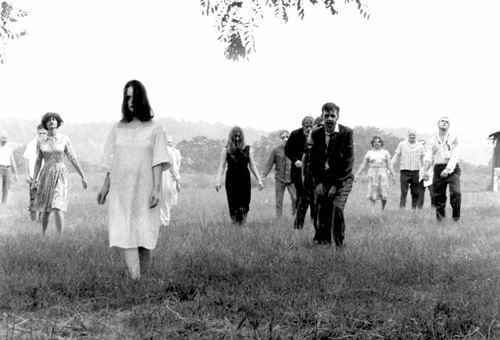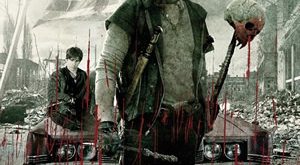“When there’s no more room in hell, the dead will walk the earth.”
Zombies are linked to the basics of human nature, they play upon our fears of infectious disease, death and turn our switches on to the need to survive. They are the walking dead, following their basic instincts, which is to feed. They are de-evolution at it’s finest and most of the time no one knows how the infection spread but it spread fast. Here is a brief history and in Part 1 of my article a list of what films zombie lovers and fans intrigued by the concept of the undead can bite into. In Part 2 there will be more zombie goodness in the form of interesting books/comics to check out and video games.
Originally derived from the voodoo word zonbi — meaning “ghost or departed spirit” — zombies have long been a horror-movie staple. Zombies come from voodoo roots. The first major mention of the word “zombie” was in William Seabrook’s sensationalized 1929 study of Haitian voodoo, titled The Magic Island. The book detailed his encounters with the living dead. He describes their features and mannerisms. In the 1930’s Hollywood was wrestling with demons, exploring the now iconic monster film. Director Victor Halperin’s cheaply made White Zombie (1932) debuted. His expressionistic entry starred Bela Lugosi as voodoo priest “Murder” Legendre, the piercing-eyed owner of a Haitian sugar mill operated by mindless human zombies. There was a sequel called, Revolt of the Zombies (1936), about a Cambodian sorcerer-priest with a secret formula to create hypnotized zombies. It was less compelling than White Zombie.
Three Monogram zombie films followed in the next decade, tying Nazism to zombie lore: the prewar King of the Zombies (1941) featuring a sinister Nazi-like doctor who conducted voodoo to create a zombie army; its quasi remake, Revenge of the Zombies (1943) (a.k.a. The Corpse Vanished), with another mad scientist creating a race of living-dead warriors for the Third Reich; and Voodoo Man (1944), a recycled Revenge of the Zombies that brought back Bela Lugosi as the voodoo master Dr. Marlowe, who kidnapped young women to use their spirits to animate his dead wife. The next significant zombie film was RKO producer Val Lewton and director Jacques Tourneur’s I Walked With a Zombie (1943), a West Indies derivation of Charlotte Brontë’s dark romance Jane Eyre.
In the upcoming decade the U.K.’s Hammer Films — a company known for churning out dozens of horror films — entered into the world of zombies with its Plague of the Zombies (1966) (a.k.a. The Zombie), visualizing the living dead as rotting, reanimated corpses. These are the zombies of the modern age, the ones we know and love now. Shortly after, George A. Romero ushered in the modern era of graphically violent and gory zombie pics with his debut horror feature, Night of the Living Dead (1968). His zombies were indiscriminate, flesh-eating ghouls (not produced by voodoo rites) who lumbered stiffly out of their graves and toward a barricaded house to attack fugitives who were hiding to escape being infected. The low-budget black-and-white film was shot documentary style with natural lighting and a hand held camera to produce the fear facing the unfortunate farmhouse occupants. Romero also used this film to provide social commentary. Critics see this film as a critique of 1960s American society, international Cold War politics and domestic racism. His next film, Dawn of the Dead (1978) further redefined the zombie genre by placing survivors in the last place of human refuge, a shopping mall. The film provides further social commentary about consumerism and human nature during an intense period of survival. Romero is known as the god father of Zombies, he completed his zombie trilogy with Day of the Dead (1985). Day of the Dead follows scientists and military officers as they preform experiments on zombies until the zombies revolt. He further contributes to the zombie genre to this day.
Romero’s influence on zombie films has been phenomenal. Many films have expanded upon the idea of the zombie and also on survival. Several films have shocked us, made us laugh and continue to engross our fascination with the living dead, Italian filmmaker Lucio Fulci’s notoriously gory Zombi 2 (1979); Zombi Holocaust (1980) (a.k.a. Zombie 3), one of many copycat Italian zombie movies; director Sam Raimi’s low-budget Evil Dead trilogy (1981, 1987, 1993) with Bruce Campbell as the cult-classic hero Ash clashing against spirit-possessed zombies; Re-Animator (1985), based on H.P. Lovecraft’s early-twenties short story about reanimation experimenter Herbert West (Jeffrey Combs); the Return of the Living Dead parody series (1985, 1988, 1993, and 2005); Wes Craven’s Serpent and the Rainbow (1988), which reconnected zombies with their voodoo roots; director Peter Jackson’s landmark Braindead (1992), the bloodiest and grossest zombie film ever made.
This leads into our list of notable zombie films fans of the genre must sink their teeth into:
Night of the Living Dead (1968) and Dawn of the Dead (1978):

Synopsis: “They’re coming to get you Barbara!”
Night of the Living Dead is a 1968 American independent black and white zombie film directed by George A. Romero. The film follows Ben, Barbra, and five others, who are trapped in a farmhouse in Pennsylvania and attempt to survive the night while the house is being attacked by mysteriously reanimated creatures, otherwise known as zombies.
Dawn of the Dead follows four survivors of the zombie apocalypse as they search for refuge ultimately finding it in a suburban shopping mall. Cultural and film historians read significance into the film’s plot, linking it to critiques of large corporations as well as American consumerism and of the social decadence and the social and commercial excess present in America during the late 1970s. These observations are still relevant in our society today.
28 days (2002) and 28 weeks later (2007):
Synopsis: 28 Days Later depicts the breakdown of society following the accidental release of a highly contagious “rage” virus and focuses upon the struggle of four survivors to cope with the ruination of the life they once knew.
28 Days Later isn’t your typical zombie movie, in fact the infected aren’t zombies at all, they never died or were devoured, they were just infected with the “rage” virus and have been stripped of their humanity except for the most basic of human functions which prone them to violence. We also see that even though the infected pose a threat to humanity it is really humans themselves that pose a threat to each other.
28 Weeks Later expands upon the infection. After the infected have died from starvation, Britain has been declared safe. People start colonizing in safe zones around the city. We follow two children as they are reunited with their family and we also find out that there is a cure, in an unlikely place and the virus is in the process of evolution.
[REC] (2007):
Synopsis: [REC] follows a television reporter, Ángela Vidal, and her cameraman, Pablo, as they are filming the night shift of one of Barcelona’s fire stations. They suddenly receive a call to an apartment complex where a woman is trapped in her apartment. Upon their arrival all hell breaks loose. There is a virulent disease in the building and once they enter they can not leave because they entered an area undergoing quarantine.
Shot hand-held documentary style [REC] creates confusion, claustrophobia and empathy for all involved. The disease spreads rapidly, those infected behave violently and try to infect others.They again aren’t your typical zombies but act like them. We also find out the unlikely cause to the virus. [REC] spawned a sequel, [REC] 2 and it’s just as frightening.
Zombieland (2009):
Synopsis: A zombie comedy, the film is set in a post-apocalyptic United States, two months after a mutated strain of mad cow disease has turned most humans into zombies. We follow four survivors as they take an extended road trip in an attempt to find a sanctuary free from zombies.
Zombieland follows a set of rules to survive throughout the film created by one of the main characters, Columbus (Jesse Eisenberg). The film is full of witty banter and clever use of pop culture references, while zombies remain the focus the comedic timing is impeccable, making the film fun instead of extremely dark.
Tokyo Zombie (2005):
Synopsis: Tokyo Zombie, another zom-comedy, follows two best friends who dream of becoming jujitsu champions. One day they accidentally murder their boss and they dump his body in a toxic waste dump known as “Black Fuji.” The situation goes from bad to worse when the dead start rising from the dump and start attacking the living.
Resident Evil Series (2002-Present):
Synopsis: The Resident Evil films follow Alice, a superhuman zombie fighting machine, as she tries to take down the Umbrella Corporation. Before she could fully act upon this, the T-virus is let out, turning a whole town into zombies and eventually much of the world becomes infected.
We have to give credit where credit is due. Despite vapid plot holes and lack of story, lack of character development, and the series barely follows the original games, Resident Evil has managed to stay strong year after year and more films are in development.
Shaun of the Dead (2004)
Synopsis: The film follows Shaun, a 29-year-old salesman whose life has no direction. He has a rocky relationship with his step-father, his girlfriend, and his housemate. As he is about to realize what his life is really like, an apocalyptic uprising of zombies occurs. At first, Shaun and his best friend Ed are too hungover to notice.
The film is praised for it’s comedic writing style, and its references to other movies, television shows, and video games. The cast is mostly comprised of British comedians and sitcom stars. There are many references to Romero’s classic zombie films and many other horror films.
Dawn of the Dead (2004 Reimaging)
Synopsis:The remake and original both depict a handful of human survivors living in a shopping mall surrounded by swarms of zombies, but the details differ significantly.
The re-imaging is directed by Zack Snyder. The 2004 remake is an excellent representation of the original, much darker and gives the zombies a more grisly appearance, also having them run instead of being slow and lumbering. Dawn of the Dead is one of the best re-makes of a horror film. It’s a great companion piece to the original.
Evil Dead (1981)
Synopsis: Evil Dead follows five college students vacationing in an isolated cabin in a wooded area. Their vacation becomes gruesome when they find an audiotape that releases evil spirits.
Not a traditional zombie movie in any sense but must be mentioned. This is also the film that gave us Bruce Campbell in all his glory! Evil Dead was controversial for it’s time, providing the audience with graphic terror, violence and gore, Sam Raimi had a difficult time getting distributor. The film has garnered a cult following to this day and two sequels, Evil Dead II and Army of Darkness.
Did I forget any of your memorable or favorite zombie films? Please let me know! Don’t forget to check out the films that were mentioned in the history section as well and remember to shop smart, shop S-Mart.
Sources: Film Wikipedia, AMC.COM-Film Critic Movie History-Bring out the Undead, IMDB.com
 Horror News | HNN Official Site | Horror Movies,Trailers, Reviews
Horror News | HNN Official Site | Horror Movies,Trailers, Reviews





